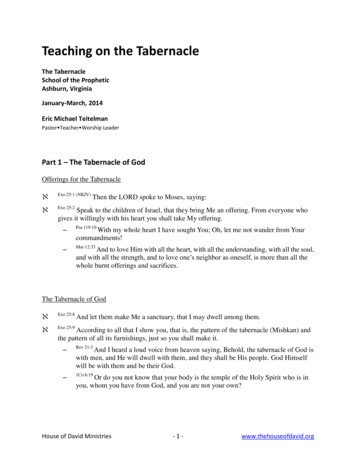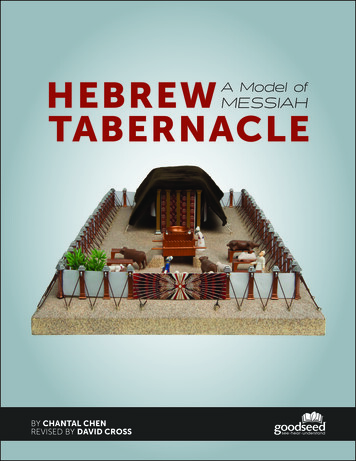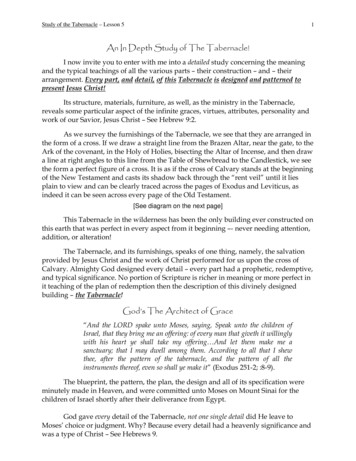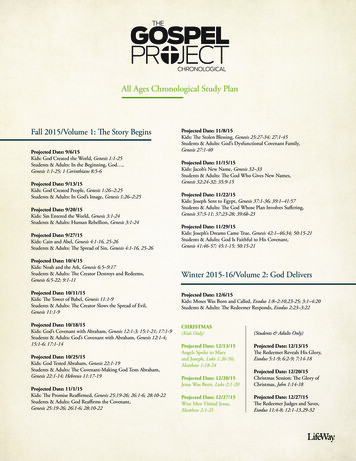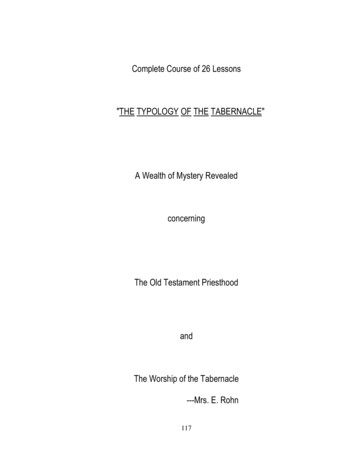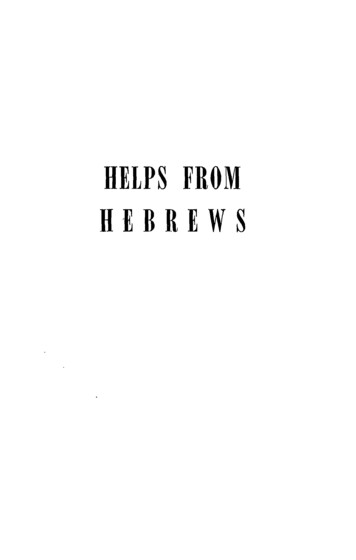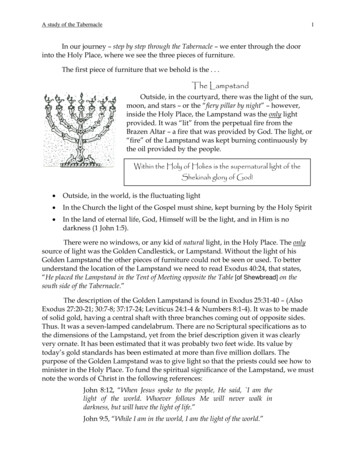
Transcription
A study of the Tabernacle1In our journey – step by step through the Tabernacle – we enter through the doorinto the Holy Place, where we see the three pieces of furniture.The first piece of furniture that we behold is the . . .The LampstandOutside, in the courtyard, there was the light of the sun,moon, and stars – or the “fiery pillar by night” – however,inside the Holy Place, the Lampstand was the only lightprovided. It was “lit” from the perpetual fire from theBrazen Altar – a fire that was provided by God. The light, or“fire” of the Lampstand was kept burning continuously bythe oil provided by the people.Within the Holy of Holies is the supernatural light of theShekinah glory of God! Outside, in the world, is the fluctuating light In the Church the light of the Gospel must shine, kept burning by the Holy Spirit In the land of eternal life, God, Himself will be the light, and in Him is nodarkness (1 John 1:5).There were no windows, or any kid of natural light, in the Holy Place. The onlysource of light was the Golden Candlestick, or Lampstand. Without the light of hisGolden Lampstand the other pieces of furniture could not be seen or used. To betterunderstand the location of the Lampstand we need to read Exodus 40:24, that states,“He placed the Lampstand in the Tent of Meeting opposite the Table [of Shewbread] on thesouth side of the Tabernacle.”The description of the Golden Lampstand is found in Exodus 25:31-40 – (AlsoExodus 27:20-21; 30:7-8; 37:17-24; Leviticus 24:1-4 & Numbers 8:1-4). It was to be madeof solid gold, having a central shaft with three branches coming out of opposite sides.Thus. It was a seven-lamped candelabrum. There are no Scriptural specifications as tothe dimensions of the Lampstand, yet from the brief description given it was clearlyvery ornate. It has been estimated that it was probably two feet wide. Its value bytoday’s gold standards has been estimated at more than five million dollars. Thepurpose of the Golden Lampstand was to give light so that the priests could see how tominister in the Holy Place. To fund the spiritual significance of the Lampstand, we mustnote the words of Christ in the following references:John 8:12, “When Jesus spoke to the people, He said, I am thelight of the world. Whoever follows Me will never walk indarkness, but will have the light of life.”John 9:5, “While I am in the world, I am the light of the world.”
A study of the Tabernacle2We proceed, with bowed heads, and a deep sense of reverence, into the HolyPlace, reserved for the priests unto God – for it is the dwelling place of God.The priests hold back the beautiful colored tapestry of the door and we step inbetween the golden pillars into the Holy Place.Are we entitled to this close relationship with God?LampstandAltar of IncenseTable ofShewbreadThe steps we have taken to get this far:1. We have passed through THE GATE that stands for the Gospels, thatis, we have accepted Christ in His four-fold character.2. We have been to the BRAZEN ALTAR, a picture of Christ’s cross, thatis, we have come to God by way of the cross.3. We visited the LAVER, that represents being cleansed, or separated,from the world and things that defile. This means that we have beenwashed in “the Laver” of God’s Word.Upon entering the Holy Place we view the room 30 feet long, 15 feet wide, and15 feet high. At first, our eyes must become accustomed to the dim light of the lamps,and we cannot help but be impressed with the sweet fragrance of burning incense. Thewalls are burnished gold, and the veil –- we have just passed through –- is of manycolors with golden needlework.In spite of all this luster, we note the simplicity of the furnishings. To our right isthe Table of Shewbread; to our life the Golden Candlestick, or Lampstand, and directlyin front of us, across the room, is the Altar of Incense.This “Candlestick” is actually seven lamps with pure olive oil for fuel –- andwicks that needed to be trimmed occasionally by tongs provided for that purpose(Exodus 25:38).The care of the lamps was a daily and continual responsibility, given in Exodus30:2-8. Every morning the priests would trim the wicks and keep the lamps filled withpure olive oil, checking them again every evening, to make sure that they were burning
A study of the Tabernacle3brightly. The priests were provided with a pair of golden scissors and snuffers for thispurpose. If the light burned low, the priests would refill the lamp, and, if the wickbecame charred, they would snuff and rim the wick and light the lamp again.Beside the pure beaten-gold candlestick, with its beautiful carving of flowers andbranches, were little cups to hold the oil. There were seven cups – three on one side andthree on the other side – shaped like almonds.In each oil-lamp was a wick that was to be trimmed with the air of pure goldtongs. The trimmings, or ashes, were to be held in a pure gold snuff-dishes (Exodus25:38) One of the duties of the priests was to trim the wick to prevent the light fromdimming, or going out altogether.The light was never to go out but was to be continually tended by Aaron, thatrequired that he daily add pure olive oil (Leviticus 24:2) This oil was a type of the HolySpirit. And, in order for our light as Christians to shine continually – Ephesians 5:18states, “be filled with the Spirit!”Because the candlestick was to burn continually before the Lord, according toExodus 27:20-21 and Leviticus 24:4, it was necessary for the priests to replenish it withoil and trim the wick twice daily, morning and evening – Exodus 30:7-8; Leviticus 24:3.Only once in Scripture is it recorded that the lamps went out (1 Samuel 3:3 & 1114). This was indicative of the backslidden condition of the priesthood at the time.There are many believers today who need to let our High Priests, Jesus Christ,trim their wicks because their lights are flickering dimly.This Candlestick gave its light on the Altar of Incense and the Table ofShewbread. It seems that many today do not see the need of the Alter of Incense(representing prayer) and the Table of Shewbread (representing Bible study). Could it bethat they have forgotten to trim their wicks, and let their light grow dim? It just may bethat their lamp needs to be trimmed of indifference, laziness, gossip, greed, etc.To keep our light burning brightly it takes re-filling our lamps with the pure oiland “snuffing” – or snipping the charred wick.Unlike the Brazen Altar, that was open to all, only priests (Today, “believers”)received the blessings of the Holy Place. The ministry at the candlestick was only forthose who had been to the Brazen Altar first, and, in godly sorrow for sin, preparedthemselves for the Holy Place. We read in 1 Corinthians 2:9-16:But as it is written, Eye hath not seen, nor ear heard, neither have entered intothe heart of man, the things which God hath prepared for them that love him.But God hath revealed them unto us by his Spirit: for the Spirit searcheth allthings, yea, the deep things of God. For what man knoweth the things of a man,save the spirit of man which is in him? even so the things of God knoweth noman, but the Spirit of God. Now we have received, not the spirit of the world,but the spirit which is of God; that we might know the things that are freely
A study of the Tabernacle4given to us of God. Which things also we speak, not in the words which man'swisdom teacheth, but which the Holy Ghost teacheth; comparing spiritual thingswith spiritual. But the natural man receiveth not the things of the Spirit of God:for they are foolishness unto him: neither can he know them, because they arespiritually discerned. But he that is spiritual judgeth all things, yet he himself isjudged of no man. For who hath known the mind of the Lord, that he mayinstruct him? But we have the mind of Christ.”Light is used in Scripture as an expression of God’s and the Christian’s character.(See Luke 2:32; 1 John 1:5; Matthew 5:16; Ephesians 5:8) Consequently, men who walkcontrary to God are said to “be in darkness” (John 3:19 & 1 John 1:6).Light is linked to Christ, and His identifies Himself as “the Light of the world.” Themeans of imparting light in the Holy Place was accomplished when the priest pouredthe pure olive oil into the lamps that produced the illumination, speaking of theillumination that is imparted by Christ.Thee is a beautiful picture here, in that the central step is typical of Christ andthe branches representative of the Church, because the Church is also the “light of theworld,” yet, what light it does have comes forth from Christ. Jesus said, “I am the vine, yeare the branches” (John 15:5).The branches were constructed so that they could not possibly be used foranything unless they were attached to the central stem. They were “curved” so that theycould not “stand alone.”Because we, as believers, are in Christ, we have become “blameless and pure,children of God without fault in a crooked and depraved generation in which we shine like starsin the universe” (Philippians 2:15), and “we were once in darkness, but now we are light in theLord,” and we, thus, “live as children of light” (Ephesians 2:8).Each of the seven lamps on the Lampstand gave an individual light, yet all wereuntied to the one central branch that literally was “in the midst.”John said in Revelation 1:12-13, “And I turned to see the voice that spake with me.And being turned, I saw seven golden candlesticks; And in the midst of the seven candlesticksone like unto the Son of man, clothed with a garment down to the foot, and a golden sasharound His chest.” Then Christ said to John in verse 20, “The mystery of the seven starswhich you saw in My right hand, and the seven golden candlesticks . . . is this, the sevencandlesticks which you saw are the seven churches.Though each candlestick (churches) was independent of each other, all wereattached to the central shaft. The Lord Jesus Christ.Each branch of the Lampstand was to have hammered out “a knob and a flowerin one branch; and three bowls made like almonds” (Exodus 25:33). It is generallybelieved that the knobs were pomegranates and the flowers were lilies. The emphasis isclearly on the almond design, reminding us of Aaron’s rod from an almond tree that
A study of the Tabernacle5budded (Number 17:1-11). Aaron’s dead almond limb came to life in the Tabernacle, anundeniable picture of resurrection – the dead coming to life. The almond tree is the first tobloom after winter, and, with its snow-white blossoms, proclaims new life. 1 Corinthians 15:20 states, “Christ has indeed been raised from the dead, the firstfruits of those who havefallen asleep.”The Table of ShewbreadExodus 25:23-30 & Leviticus 24:5-9In our journey, step by step through theTabernacle we have come through the gate,past the Brazen Altar and Laver in thecourtyard and, then passing through thedoor of the Tabernacle proper, we enteredthe door into the Holy Place – a beautifullyelegant room, 30 feet long, 15 feet wide and15 feet high. On the left we saw the GoldenLampstand, and just opposite it on the right stand the Table of Shewbread.Once inside the Holy Place, the priests were surrounded by immaculate beauty.The walls of the Holy Place were made of boards of acacia wood standing up (Exodus26:15). The boards were overlaid with gold (Exodus 26:29).Inside the Tabernacle proper, with the exception of the beautiful four-coloredceiling embroidered with images of cherubims, one is completely surround by wall andfurniture made of approximately one and one-fourth tons of pure gold! This is theatmosphere in which the priests ministered at he Tale of Shewbread.The specifications of the constructions of the Table of Shewbread are given inExodus 25:23-24 – It was 36 inches long, 18 inches wide, and 27 inches high.The edge of the table top has a golden molding, orcrown., very beautiful, ornate in design. Exodus 25:24describes, “a border of a handbreadth round about the table agolden crown that went around the edge of the table top.” Thismeans that a rim protruded up “a hand breadth” – (4 and ½inches) – probably to contain the bread and variousvessels that sat on the table.I show two very different conceptions of what theTable of Shewbread must of looked like because it is notclear from the Hebrew language whether the shewbread was in two “piles” or in two“rows.” –- [so I show you both thoughts]Let’s see exactly what Scripture teaches. In Leviticus 24:5-6 we find these words.“And thou shalt take fine flour, and bake twelve cakes thereof: two tenth deals shall be in onecake. And thou shalt set them in two rows, six on a row, upon the pure table before the LORD.”
A study of the Tabernacle6This is from the King James Translation. The word translated as “rows” here isfrom the Hebrew word, “ma'areketh,” that means, "an arrangement.” This is not the sameHebrew word that means to designate rows side by side as is found in Exodus 28:17-20& 39:10-13 and 1 Kings 6:36 & 7:2-42. The Hebrews word “ma areketh” can refer to cakesstacked one on the other in a pile, as some Bible students interpret it, or this Hebrewword could just as well refer to cakes laid out in rows on the Table of Shewbread.Leviticus 24 goes on to describe that a “gold dish of frankincense at the top of theshewbread.” The burning of the frankincense at the top of the stacks made the showbreadan offering by fire to God, as mentioned in Leviticus 24:7. The loaves were not burnedin the fire, because they were to be eaten by priests in the Holy Place as the most holy ofthe offerings (Leviticus 24:9). They became "a memorial, even an offering made by fire"through the bowls of burning frankincense on top of the shewbread.The showbread was to be on this table that was covered with pure gold and purefrankincense was burned on the pure table, signifying that all things connected with theworship of God was to be pure. This typifies the purity of life of the worshipers whocame before God.At the four corners of the Golden Table of Shewbread were gold rings throughwhich the staves, or poles, were placed so that the table could be carried by theIsraelites as they marched from place to place. The staves were also made of acaciawood covered with pure gold. Like all the other pieces of furniture in the Tabernacleproper the Table of Shewbread was never seen –- except by the priests as theyministered in the Holy Place. The priests would carefully cover it and put the stavesthrough the gold rings before the Levites carried it on the wilderness journey.The specifications of the Table of Shewbread also include some accessories foundin Exodus 25:29, that states, “Thou shalt make the dishes thereof, and spoons thereof, andcovers thereof, and bowls thereof, to cover withal; of pure gold shalt thou make them.”The vessels –- dishes, bowls, and spoons were made of pure gold (Ex.odus25:29& 37:16). These were with the Table of Shewbread to use for the incense, meat and drinkofferings with the twelve loaves of bread that symbolized the twelve tribes being in theDivine Presence. The twelve loaves of shewbread were placed on the table; exchangedfor fresh loaves every Sabbath. Incense was burned in a container placed on the top ofeach loaf, signifying the worship of the twelve tribes (Exodus 25:30 & Leviticus 24:5-9).The dishes were receptacles in which the shewbread was mixed. The spoons were smallcensers in which incense was burned (Numbers 7:14, 20, 26, 32, 38, 44, 50, 56, 62, 68, 74,80, 86). The bowls held the blood of sacrifices and offerings (Exodus 25:29 & 37:16;Numbers 4:7). The covers were large goblets or cups that held wine to be poured outbefore the Lord every Sabbath when the bread was changed. The Hebrew word forcover means to pour, so whatever the bowls were used for, the contents were to bepoured out. The Septuagint reads, "make its plates and its incense vessels and its libationvessels and the cups with which thou shalt pour out libations" (Exodus 25:29).
A study of the Tabernacle7A cloth of blue covered the table on which were placed the platters for the bread,the censers for incense, the goblets for wine, and the cups for pouring out the drinkofferings before God (Numbers 4:7). The table was placed on the north side of theTabernacle in the Holy Place (Exodus 26:35) -- the direction of heaven (Isaiah 14:12-14 &Psalm 75:6-7). In travel a cover of scarlet and then one of badger skins was placed overthe table and its vessels (Numbers 4:8). See Exodus 35:13 & 39:36; 1 Kings 7:48; 1 Chroncles 9:32; 23:29; 28:16; 2 Chronicles 2:4; 13:11; 29:18; Nehemiah 10:33; Hebrews 9:2.The “dishes,” or plates, were to hold the loaves. The “spoons” were small cupsthat were filled with incense and burned on top of the shewbread (Leviticus 24:7 &Numbers 7:14). The “covers” are believed to have been “flagons,” or “chalices” used inthe rite of the drink offering (Numbers 28:7).Exodus 40:22 states, ”And he (Moses) put the table (the Table of Shewbread) in thetent of the congregation (the Tabernacle) upon the side of the Tabernacle northward, without theveil, (outside the veil separating the Holy Place and the Holy of Holies.)”The Table of Shewbread was only 37 ½ inches high – indicating that all of theprovisions of God are within reach of anyone.Exodus 40:23 states, “And he (Moses) set the bread (the Shewbread) in order upon it(upon the Table of Shewbread) before the Lord; as the Lord had commanded.”This Table of Shewbread standing in the Holy Place, on the north side, oppositethe Lampstand, was unlike all the other furniture, in that its significance was not foundin the table itself, but rather with what was upon it. Upon this table were 12 loaves ofbread called, “shewbread,” or, in the literally Hebrew, “bread of my face.”God said to Moses in Exodus 25:30, “And thou shalt set upon the table shewbreadbefore Me always.” The shewbread was made of fine flour (Leviticus 24:5). Some Biblestudents believe that the shewbread was placed in two stacks, or piles, of six loaves eachin each pile –- while others interpret Leviticus 24:6 to mean, “two rows” with six loavesin each row. The Scripture simply does not speak conclusively on this issue. However,we do know that, on each loaf – or each stack of loaves – was a golden censer filled withincense.Imagine this golden Table of Shewbread with twelve flat cakes called“shewbread” –- meaning “bread of my face” – or – “The Bread of Presence.” The incense offrankincense was placed on top of the loaves in golden dishes, or containers. EverySabbath new shewbread was “arranged” in order before the Lord. What happened to theold shewbread? Leviticus 24:9 states, “It (the old shewbread) belongs to Aaron and hissons, who are to eat it in the Holy Place, because it is a most holy part of their regular share ofthe offerings made to the Lord by fire.”It was considered sacrilegious for anyone except the pries to eat this leftovershewbread (1 Samuel 21:2-3 & Matthew 12:4).
A study of the Tabernacle8The Shewbread was reserved for those who worshipped and served the Lord.The priests were given other food to sustain them, however, the eating of this bread waswith a deep awareness of its spiritual significance and holiness.Bread is typical of the provisions of life, and represent God providing for Hispeople who dwell in His midst.In the New Testament bread is symbolic both of the living and the written Wordof God. Jesus said, “I am the bread of life: he that cometh to me shall never hunger; and he thatbelieveth on me shall never thirst (John 6:35) and in verse 51, He said, “I am the living breadwhich came down from heaven: if any man eat of this bread, he shall live for ever: and the breadthat I will give is my flesh, which I will give for the life of the world.”Jesus Christ is the origin of spiritual life, but to remain in good spiritual healthone must have regular nourishment from the Word of God.This bread constituted the food for the priests. About this table the priestsworshiped and fellowshipped daily –- on the basis of the blood of the sacrificial animalslain on the Brazen Altar, and the cleansing of the water of the Laver! Christ is not onlyour “Life-giver” – He is also our “Sustainer,” as well.Around this Table of Shewbread the priests gathered for joyous communion.We, as New Testament priests, ministering unto the Lord, coming by way of blood andthe cleansing Laver of His Word, seek close fellowship and worship with other saints.As we learn more of Jesus –- our Bread of Life –- (by way of His Word) –- we are“feeding on Him,” like these priests fed upon the Shewbread. Christ provides bread thatsatisfies the soul (John 6:35, 48 & 51). The assembly of the saints should be a time ofworship, devotion, and feasting upon Chris, the Living Bread.Job said, “I have treasure the words of His (God’s) mouth more than my daily bread(Job 23:12).Jesus said, “Man does not live on bread alone, but on every word that comes from themouth of God” (Matthew 4:4).Eating of good food is delightful and rejuvenating. Similarly, Jeremiah describesthe ingesting of God’s Word as, “When your words came, I ate them; they were my joy andmy heart’s delight, for I bear Your name, O Lord God Almighty.” (Jeremiah 15:16).The fact that only the priests could eat the shewbread is very significant. Wehave already concluded, all Christians are priests unto God! As Christians we all have thesame relationship to God, nevertheless, we do not all have the same degree offellowship. To use an illustration from the Tabernacle, many Christians are still in thecourtyard, refusing to daily wash at the laver, while others – who have confessed andforsaken all known sin – are serving God in the Holy Place. It is only in the Holy Placeof the Christian life –- (close fellowship with God) –- that the Word of God can be thejoy and rejoicing of the believer’s heart.
A study of the Tabernacle9The Table of Shewbread was in the Holy Place, a place where the priests wereseparated from the cares, desire, and distractions of the world. This surely, speaks ofsome location where we can be alone to partake of God’s written Bread of Life, if God isto be all that He intends to be in our life.The priests were to eat at this table “STANDING UP.” There were no chairs forthem to sit down. This was not a place of ease and entertainment, but rather it was aplace of work and service. They ate “standing up,” ready to do about the business ofserving the others. Any moment they might receive orders to move on and they must beready to pick up and leave (1 Corinthians 11:26).Lessons To Be Learned1. The Shewbread was made of “fine flour,” – picturing Christ’s perfecthumanity. In Him is no roughness or unevenness. He is flawless, without sin.2. There was to be “no leaven” in the shewbread – picturing Christ’s sinlessness(1 Corinthians 5:6-8).3. The Shewbread was “baked with fire,” – picturing Christ’s suffering.4. Frankincense, the incense that was used, pictures Christ’s fragrant life.Ever wondered why some Christians read the Bible and seem to get so much outof it, while others find it so boring and confusing? The reason is that some believers areserving the Lord in the “Holy Place,” (the place of God’s divine presence) while othersare still lingering in the courtyard. If God’s Word has lost its joy and rejuvenatingpower, maybe we need to come into the place of close fellowship with the Lord JesusChrist by way of the Brazen Altar and the Laver
Because the candlestick was to burn continually before the Lord, according to Exodus 27:20-21 and Leviticus 24:4, it was necessary for the priests to replenish it with oil and trim the wick twice daily, morning and evening – Exodus 30:7-8; Leviticus 24:3. Only once in Scripture is it rec



